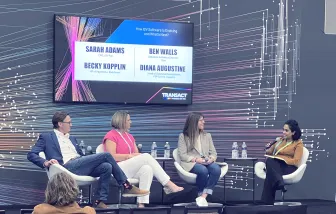ISVs: Adapt to the Growing Demand for Contactless Payments
Listen to this article

Contactless payment adoption continues to grow. A Mastercard poll found that contactless payments have passed the tipping point with more than half, 51%, of consumers now using contactless cards and mobile wallets.
What’s Driving Contactless Payments?
Consumers gravitate toward frictionless payment experiences. Speed, ease of use, and convenience will always win out over slow, clunky processes. That makes contactless payments, which remove much of the friction from payments, a go-to choice. Using contactless, customers making purchases only have to wave their contactless cards or tap them on a merchant’s near-field communication (NFC) enabled payment device. More consumers are also using mobile wallets, which work much the same way at the checkout. However, it’s the consumer’s phone, not a chip inside the contactless card that communicates with the payment device. So, for the quick stop at a convenience store, payment at the food truck or lunch counter, or fast payment in a line at the mall, contactless is often the payment method of choice.
Also, in a post-pandemic world, consumers are more aware of the risks of using shared devices. Contactless payments allow them to complete shopping journeys with minimal physical interaction, decreasing the chances they’ll contract a virus.
ISVs Need to Take a Big-Picture View
Contactless payments run on the same rails as EMV payments, so virtually all payment processing partners support them. However, you should be aware that the transaction process at the checkout differs than when consumers “dip” their EMV cards. Contactless payments require a payment device with NFC capabilities to capture cardholder data. NFC is a form of RFID technology that enables data transfer from chip to device across a distance, usually less than 4 cm. So, keep in mind that the payment technology devices you integrate to your software will affect the customer experience. How quick and responsive it is, and even how well displayed where the consumer should tap their cards, will impact the friction associated with the process.
Your clients also need to address contactless payment limits. Financial institutions set limits, before the customer has to present the card and sign or enter a PIN. The point of sale (POS) and payments system you provide should facilitate high-value purchases with contactless cards as user-friendly as possible.
Another thing ISVs need to consider is that consumers don’t expect to make contactless payments only at the checkout. Consumers who are prepared only to pay with a mobile wallet will want to use it at a self-service kiosk, at concession stands, for mass transit ticketing, and many other use cases. Payment terminals for use in kiosks and mobile payment devices are available that allow merchants to accommodate these consumers.
Additionally, SoftPOS, also called Tap to Pay, which allows merchants to accept contactless payments directly on a smartphone or other mobile device, can accommodate payments beyond the checkout counter. SoftPOS can complement existing payment solutions that merchants currently use, giving them easy mobile POS options. Consider offering a total solution that allows your clients to accept contactless payments anywhere.
It's Time for a Solution Refresh
Consumer payment preferences are changing, and with their convenience, ease of use, and speed, the contactless payments trend will likely continue to gain momentum. Evaluate the solutions you provide from this perspective and ensure you are delivering the best experiences to merchants and their customers.
To learn more about optimizing solutions for contactless payments, contact us.










